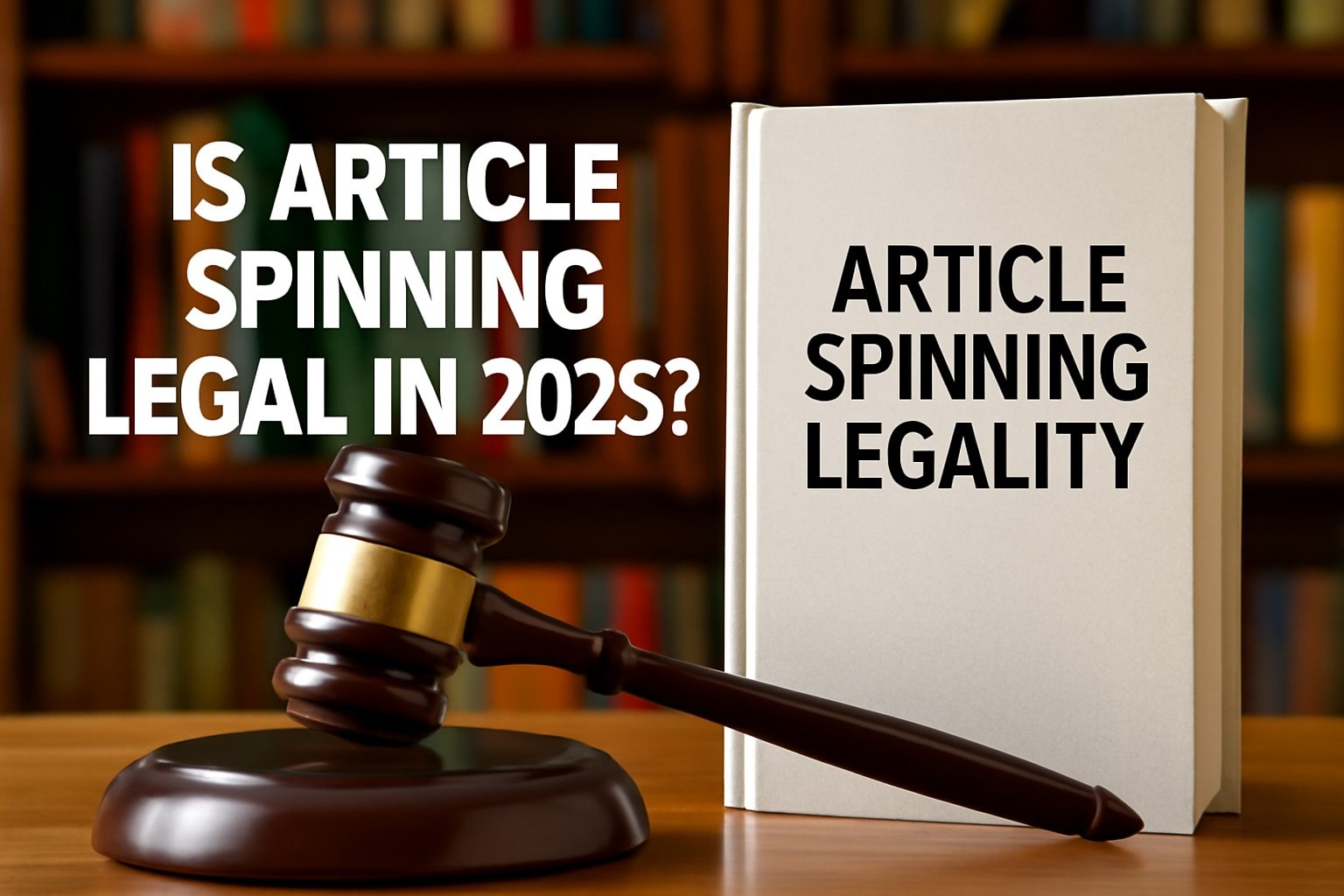What is Article Spinning in SEO?
Before diving into the legalities, it’s essential to understand what article spinning is, especially its role in SEO (Search Engine Optimization).
Article spinning refers to the process of taking an existing article and using software or manual methods to rewrite or “spin” the content into different versions. This allows marketers to produce large volumes of content without creating each piece from scratch. While this practice can be beneficial for scaling content quickly, it often raises concerns about content quality, originality, and, most importantly, its legal status.
What is Article Spinning Used for?
-
SEO: One of the main uses of article spinning is to create multiple variations of a single article to build backlinks and increase website traffic. SEO specialists would use spun content to target various keywords while avoiding penalties from search engines like Google.
-
Content Marketing: Spun articles can be used to populate blogs, social media posts, and other online platforms.
-
Backlinking: Article spinning allows marketers to post variations of a single article across different platforms, helping to build backlinks and boost domain authority.
Despite these uses, article spinning has become controversial as search engines and legal systems have become more sophisticated.
History of Article Spinning
Article spinning gained popularity in the early 2000s when it was considered a quick way to boost SEO rankings. By generating unique content, marketers could flood search engines with articles, leading to higher visibility. However, as Google’s algorithms evolved, specifically with updates like Panda and Penguin, spun content began to lose its effectiveness.
Over time, search engines became more adept at identifying and penalizing low-quality, spun content. As a result, marketers had to shift towards creating higher-quality, original content.
Legal Considerations of Article Spinning
When it comes to legal issues, article spinning has always walked a fine line. While it may not always be explicitly illegal, it can lead to several legal and ethical concerns.
Copyright and Intellectual Property
Article spinning can infringe on copyright laws if the original content being spun is copyrighted and not properly attributed. Spinning content too closely to the original without providing proper citation or transformation could lead to copyright infringement claims.
-
Content Ownership: When spinning content, the question arises: who owns the final product? This becomes particularly tricky when the spun article is based on someone else’s work.
-
Fair Use Doctrine: In some jurisdictions, article spinning may be protected under the fair use doctrine, which allows limited use of copyrighted material for transformative purposes. However, this is a gray area and varies depending on jurisdiction.
Plagiarism
Even though spun articles might seem like new pieces of content, they can still be considered plagiarism if they closely resemble the original. Many article spinning tools aim to make minor changes to the text, but these changes aren’t always enough to avoid plagiarism concerns.
-
Detection: Search engines like Google use sophisticated algorithms to detect plagiarism and duplicate content. If spun content is flagged, it can lead to penalties that negatively impact SEO rankings.
Potential Legal Consequences
While article spinning itself may not always be illegal, the potential consequences can be severe:
-
Legal Action: Copyright holders or original content creators may take legal action against individuals or companies using spun content without permission.
-
Search Engine Penalties: Google and other search engines may penalize websites that engage in practices like article spinning, which can lead to a decrease in rankings or even removal from search results.
-
Fines and Settlements: In some cases, companies found guilty of using copyrighted spun content may be required to pay fines or settle claims.
As we approach 2025, it’s essential for content marketers to be cautious when using article spinning to avoid these legal pitfalls.
Regulations and Guidelines on Article Spinning in 2025
With the rise of digital marketing and content creation, there are now more regulations surrounding article spinning than ever before. While the practice itself isn’t illegal in all jurisdictions, certain guidelines and rules apply in 2025.
The Role of Search Engines
Google, in particular, has been very vocal about its stance on spun content. Google’s algorithm is designed to reward high-quality, original content and penalize sites that attempt to manipulate rankings through low-quality or spun content.
-
Google’s Policy on Content Quality: Google’s Quality Rater Guidelines stress that websites should focus on E-A-T (Expertise, Authoritativeness, and Trustworthiness), which spun content often fails to meet.
-
Algorithm Updates: With updates like Panda and Penguin, Google has continuously cracked down on black-hat SEO techniques, including article spinning. These updates have made it harder for spun content to rank well in search results.
Legal Framework and Regional Differences
-
USA and Europe: In the United States and Europe, laws on content creation are strict, and content marketers must adhere to intellectual property laws, including avoiding copyright infringement through spinning. The EU’s General Data Protection Regulation (GDPR) and Digital Services Act (DSA) can affect how spun content is used, especially in terms of data privacy.
-
Asia and Other Regions: Some countries have more lenient laws when it comes to content spinning. However, even in regions where laws are less strict, ethical marketing and high-quality content are still vital for long-term success.
The Impact of Article Spinning on SEO and Content Marketing
Although article spinning is still used by some marketers, its impact on SEO and content marketing has become less favorable.
SEO Consequences of Using Spun Content
-
Ranking Penalties: Using spun content can result in penalties from Google, leading to a decrease in rankings or even removal from search results.
-
Thin Content: Spun articles often result in thin content—low-value content that doesn’t provide meaningful information. Search engines may devalue such content, reducing the website’s overall authority.
-
Inconsistent User Experience: Spun content often lacks consistency in tone, voice, and quality, which can lead to a poor user experience and a higher bounce rate.
Long-Term Effects on Content Marketing
-
Brand Reputation: Relying on spun content can harm a brand’s reputation if customers or competitors notice the low quality of the content.
-
Lower Engagement: Low-quality, spun content is less likely to engage readers or generate social media shares, which can negatively impact overall marketing performance.
Risks and Drawbacks of Article Spinning
There are numerous risks associated with article spinning, both legal and practical. Some of the most significant drawbacks include:
-
Legal Issues: As mentioned earlier, article spinning can lead to legal action if it infringes on copyright laws or is deemed plagiarized.
-
SEO Penalties: Websites that rely on spun content may face penalties, reducing their visibility and organic traffic.
-
Content Quality: Spun content often lacks the depth and value required to rank well on search engines and engage readers.
-
Ethical Concerns: Spinning content without proper attribution or transformation raises ethical concerns about originality and content ownership.
Alternatives to Article Spinning
Rather than relying on article spinning, there are several alternatives that can help content marketers scale their efforts without compromising quality or legality.
High-Quality Content Creation
-
Hiring Writers: Content marketers can hire professional writers to create original content that adds value to their audience.
-
Repurposing Content: Repurposing existing content into new formats (e.g., turning blog posts into videos, infographics, or podcasts) can help generate fresh content without the risks of spinning.
AI Content Generation
AI tools are becoming more advanced and can generate high-quality, original content with minimal effort.
-
AI Content Generators: Tools like GPT-3 (and its successors) can create articles that are well-written, unique, and valuable to readers, making them a better alternative to article spinning.
-
AI Spinners: While AI spinners can assist with content creation, they are usually more sophisticated than traditional article spinners, and their output tends to be more original.
The Future of Article Spinning
As we move toward 2025, the future of article spinning remains uncertain. While it is unlikely to be completely eliminated, the rise of advanced AI technologies and stricter legal frameworks could make traditional article spinning obsolete.
Advancements in AI
As AI tools become more advanced, content creation will shift towards high-quality, AI-generated content that adds genuine value rather than relying on spun articles.
Legal Developments
As laws evolve, it is likely that new regulations will be introduced to govern the use of spun content, especially as AI and automation continue to play a role in digital marketing.
Conclusion
In 2025, article spinning remains a controversial and risky practice. While it may not be outright illegal, the legal and SEO risks associated with it make it an outdated strategy for modern content marketing. As search engines continue to prioritize original, high-quality content, marketers should focus on creating valuable content rather than relying on spinning techniques. By adopting better content creation practices and leveraging AI technology, businesses can avoid the pitfalls of article spinning and build a more sustainable online presence.

AI writing strategist with hands-on NLP experience, Liam simplifies complex topics into bite-sized brilliance. Trusted by thousands for actionable, future-forward content you can rely on.

